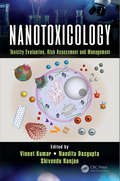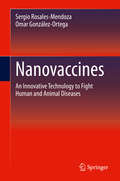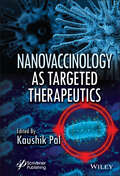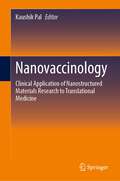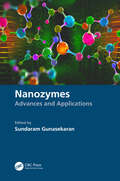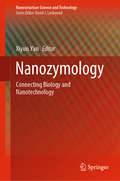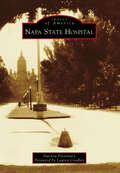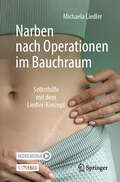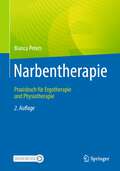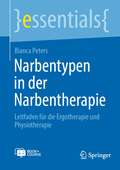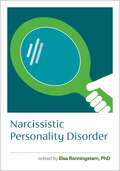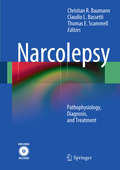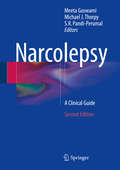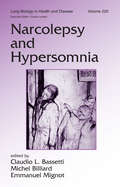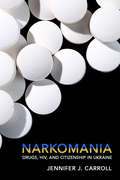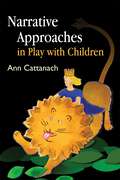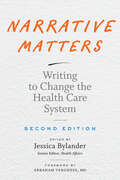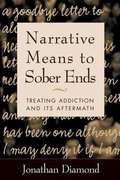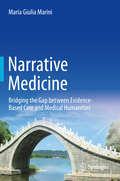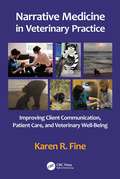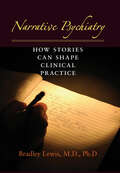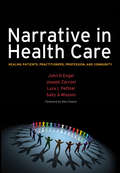- Table View
- List View
Nanotoxicology: Toxicity Evaluation, Risk Assessment and Management
by Vineet Kumar, Nandita Dasgupta and Shivendu RanjanAs the application of nanotechnology in the myriad disciplines of science and engineering--from agriculture, pharmaceuticals, material science, and biotechnology to sensors, electronics, and mechanical and electrical engineering--brings benefits it also can produce serious threats to human health and the environment that must be evaluated. The unique properties of nanomaterials make them different from their bulk counterparts. In addition to such unique properties, the nanometric size of nanomaterials can invite some detrimental effects on the health and well-being of living organisms and the environment. Thus, it is important to distinguish nanomaterials with such ill effects from nanomaterials with no or minimum toxicity. Nanotoxicology: Toxicity Evaluation, Risk Assessment and Management covers issues such as the basic principles of nanotoxicity, methods used for nanotoxicity evaluation, risk assessment and its management for nanomaterial toxicity with a focus on current trends, limitations, challenges, and future directions of nanotoxicity evaluation. Various experts from different countries discuss these issues in detail in this book. This will be helpful to researchers, educators, and students who are interested in research opportunities for avoiding the environmental and health hazards of nanomaterials. This book will also be useful for industrial practitioners, policy makers, and other professionals in the fields of toxicology, medicine, pharmacology, food, drugs, and other regulatory sciences.
Nanovaccines: An Innovative Technology to Fight Human and Animal Diseases
by Sergio Rosales-Mendoza Omar González-OrtegaThis book provides a compilation of the current developments in mucosal nanovaccines, which are an attractive approach to fight against infectious and non-communicable diseases. Since nanomaterials possess unique properties; many of them have a positive effect on vaccine efficacy when used as antigen carriers and have been applied in vaccinology with significant advances over the past years. This book addresses the methodologies for mucosal nanovaccines synthesis; based on the following nanomaterials: gold, PLGA, silica, and chitosan nanoparticles; as well as nanogels, carbon nanotubes, liposomes, and Virus-like particles. A description of the immunogenic properties of the mucosal nanovaccines is presented, highlighting the improvements achieved with this approach when compared to conventional formulations. Mucosal vaccines constitute the most practical immunization approach since they are easy to administer (promoting patient´s comfort and increasing compliance), allow triggering relevant immune responses at both the site of administration and distant compartments, and thus may protect the main entry portal for pathogens (oral, nasal, and genital mucosae). In this context, the potential of nanovaccines to result in new mucosal formulations in the benefit of global health is analyzed. Covers the synthesis and functionalization of nanomaterials for the development of nanovaccines;Discusses the underlying mechanisms involved in the induction of immune responses through mucosal compartments and the advantages of nanomaterials in the formulation of nanovaccines;Transmits the state of the art for the development of mucosal nanovaccines;Provides routes for the design and evaluation of mucosal nanovaccines;Presents key perspectives for the field of mucosal vaccine development.
Nanovaccinology as Targeted Therapeutics
by Kaushik PalNANOVACCINOLOGY AS TARGETED THERAPEUTICS The book presents the early-stage development of nanovaccines that could well be the new generation of vaccines which have a great potential for the prevention and treatment of many diseases. Nanovaccinology as Targeted Therapeutics explores recent breakthroughs in the exciting new field of micro- and nanofabricated engineered nanomaterials. In addition to spectroscopic characterizations, significant topics for interdisciplinary research, especially in the fields of nanogels, which deal with polymer chemistry, nanotechnology, materials science, pharmaceuticals, and medicine are explored, where their small dimensions prove highly advantageous. Nanovaccinology could potentially revolutionize conventional therapy and diagnostic methods due to its superior effectiveness over its macro-sized counterparts in almost all biomedical areas. Strong interest in this novel class of material has driven many studies to discover biogenic production methods and new areas of potential utilization in this area. Therefore, it is important to keep abreast of the development of these biomedical research aspects highlighted in the 19 chapters of this book written in diverse fields of studies, and their emerging applications utilized in next-generation techniques. Audience Biotechnologists, nanotechnologists, materials scientists, biochemists, medical biologists, drug delivery and formulation chemists, virologists and pharmacists.
Nanovaccinology: Clinical Application of Nanostructured Materials Research to Translational Medicine
by Kaushik PalThis book provides an overview of the cumulative work on a driving force for innovation in medicine and modern healthcare, boosting advances in therapeutics, biosensors, vaccines, and clinical systems. The work presented shows how nanoparticles have been investigated as vaccine adjuvants because they possess chemical and structural properties that improve immunogenicity as well as the use of nanotechnology in the construction of immunization systems that has developed into the field of viral nanovaccinology. The volume highlights potential areas of research, innovation, and development of finished products for future commercialization and significant research exploration through nanoparticles that prove capable of surmounting most of the barriers like toxicity issues, clearance from biological system, DNA instability, and differences in expression systems. The contributing authors review the primary literature on principles, limitations, and recent breakthroughs in nanoparticle-based antigen delivery vehicles, their use in different diseases, the major bottlenecks, and related issues. Highlighting advances in nanoparticle engineering and the understanding of nanoparticle characteristics as well as critical legacy work dome in the field of nanobiotechnology, the book is ideal for a range of researchers and students in the pure and applied sciences devoted to nanomaterials, vaccinology, and translational medicine.
Nanozymes: Advances and Applications
by Sundaram GunasekaranThis book presents the state-of-the-art advances and applications of nanozymes, the recently developing branch of enzymology that synthesizes and uses nanomaterials that mimic the function of traditional enzymes. During the past decade, the study of nanozymes has grown rapidly. Several new nanomaterials that exhibit enzymatic actions have been identified, along with new applications for their practical use. This book draws upon the work of experts from around the world and provides an in-depth analysis and cutting-edge overview of nanozymes, with an eye toward their present and future applications. Chapters are arranged in a logical order to provide physio-chemical characterization of nanozyme and basic mechanisms of their enzymatic actions. Focusing on current limitations of nanozymes and their reaction kinetics, the book presents a comprehensive discourse on nanozyme engineering that includes possible surface modifications to enhance nanozyme effectiveness. It also focuses on traditional and novel nanozyme applications, such as biosensing, drug delivery, and disease therapy, as well as their use as antibacterials. An important addition in this book is the summary of emerging literature on nanozyme toxicology. This book is intended as a ready reference for advanced undergraduate and graduate students doing research in nanotechnology; materials science; chemistry; and chemical, biological, biomedical, and food engineering. Research and development scientists, engineers, and technologists working in the chemical and biological/biomedical industries will gain much from the materials in this book for their industry practice. Presents a comprehensive discourse on nanozyme engineering that includes possible surface modifications to enhance nanozyme effectiveness. Discusses metal organic frameworks as nanozymes. Reviews on traditional and novel nanozyme applications, such as biosensing, drug delivery, disease therapy, and their use as antibacterials. Examines nanozyme toxicology. Dr. Sundaram Gunasekaran is a Professor in the Department of Biological Systems Engineering at the University of Wisconsin–Madison.
Nanozymology: Connecting Biology and Nanotechnology (Nanostructure Science and Technology)
by Xiyun YanThis book introduces the new concept of “nanozyme”, which refers to nanomaterials with intrinsic enzymatic activity, rather than nanomaterials with biological enzymes incorporated on the surface. The book presents the cutting-edge advances in nanozyme, with emphasis on state-of-the-art applications in many important fields, such as in the biomedical fields and for environmental protection. The nanozyme is a totally new type of artificial enzyme and exhibits huge advantages over natural enzymes, including greater stability, low cost, versatility, simplicity, and suitability for industry. It is of interest to university researchers, R&D engineers, as well as graduate students in nanoscience and technology, and biology wishing to learn the core principles, methods, and the corresponding applications of “nanozyme”.
Napa State Hospital
by Lauren Coodley Patricia PrestinaryNapa, because of its natural beauty and optimal conditions for "moral treatment," was chosen as the second site for a state hospital to ease overcrowding in Stockton Asylum. When the fully self-sustaining Napa Asylum opened in 1875, it quickly filled to capacity and became home to many people suffering from mental illness, alcoholism, grief, and depression. In 1924, Napa Asylum was renamed Napa State Hospital to reflect changes in the medical model and treatments for psychiatric patients. Covering the first 100 years of the hospital's history, this unique book tells the story of the institution and the people for whom it served as employer. Known locally as Imola, this beautiful site became an integral part of the community.
Narben nach Operationen im Bauchraum: Selbsthilfe mit dem Liedler-Konzept
by Michaela LiedlerIn diesem Ratgeber erhalten Sie umfassende Einblicke im Umgang mit Narben bei Beschwerden nach einer Operation im Bauchraum und deren Auswirkungen auf den restlichen Körper. Sie lernen praktische Techniken zur Selbsthilfe, die Ihnen schnell und effektiv Linderung verschaffen. Gleichzeitig erfahren Sie, den Schmerz als eine Art der Kommunikation Ihres Körpers zu verstehen und wie Sie mit akuten und langanhaltenden Schmerzen umgehen können. Aus dem Inhalt: Fachwissen über die Funktionsweise und Funktionsstörungen des Körpers, Verklebungen von Faszien im Gewebe und Verwachsungen im Bauchraum, Indikationen und Kontraindikationen für die Behandlung der Narbe, Eigenübungen für jedes Stadium der Wundheilung, Alltagsbewegungen und Schlafpositionen, Fragen und Antworten aus dem Alltag mit Narben, Plus: Videos mit Übungsanleitungen via Springer Nature More Media-App
Narbentherapie: Praxisbuch für Ergotherapie und Physiotherapie
by Bianca PetersDieses Praxisbuch vermittelt alles Wesentliche für die Behandlung verschiedener Narbentypen in Ergotherapie und Physiotherapie. Wie beeinflusst ein Vitamin A-Mangel die Narbenheilung? Welche Kontraindikationen gibt es für die Narbenmassage parallel zur Narbe? Welche Faktoren können zur Stagnation des Heilungsprozesses führen und wie kann ihnen entgegengewirkt werden? Die Expertin liefert Ihnen die Antworten.Aus dem Inhalt:• Aufbau der Haut, Wundheilung, Ödembildung, Schmerzentwicklung und verschiedene Narbentypen• Befund inklusive Anamnese, Inspektion, Palpation und Funktionsprüfung• Behandlungstechniken mit und ohne Hilfsmitteln, Biofeedback, Thermotherapie und Taping u.v.m.• Hausaufgabenprogramm für Patient*innenPlus: Befundbogen, Narbenprotokoll und Reflexionsbogen zum DownloadNeu in der 2. Auflage: Komplett überarbeitet und aktualisiert; neue Kapitel zum Einfluss von Medikamenten und Hormonen auf die Wundheilung
Narbentypen in der Narbentherapie: Leitfaden für die Ergotherapie und Physiotherapie (essentials)
by Bianca PetersNach einer Operation, einem Gewebstrauma oder auch nach Bestrahlung kann es zu auffälligen Narben mit wulstigem, atrophem oder auch fibrotischem Wachstum kommen. Treten hierbei mittel- bis langfristig Beschwerden bei Patient*innen auf, so sollte die jeweilige Narbe entsprechend behandelt werden. Tiefergehende Kenntnisse über die Hautschichten und Wundheilungsstörungen sind für die zielgerichtete Behandlung hilfreich. Im vorliegenden essential werden wichtige Narbentypen und deren Besonderheiten schrittweise erklärt. Konkrete Vorgehensweisen bei schlecht heilenden, schmerzenden, oder trockenen und juckenden Narben werden besprochen.Den kostenlosen Zugang zum Online-Kurs finden Sie direkt im Buch.
Narcissistic Personality Disorder
by Elsa RonningstamThis volume presents significant recent advances in research and clinical practice in the area of pathological narcissism and narcissistic personality disorder (NPD). Originally published as a Special Supplement to the Journal of Personality Disorders, the book brings together leading clinical experts. Chapters examine the neuroscientific and psychological underpinnings of NPD, describe cutting-edge diagnostic approaches, and explore the complexities of the therapeutic relationship. Addressing the "dos and don'ts" of clinical work with this population, the book reviews the status of specialized treatment strategies--such as transference-focused psychotherapy and mentalization-based treatment--and identifies important directions for future research.
Narcolepsy
by Thomas E. Scammell Claudio L. Bassetti Christian R. BaumannThe field of narcolepsy has developed enormously within the last 10 years. Indeed the understanding of the basics of sleep-wake regulation and the discovery of new neurotransmitter systems (the hypocretins) has boosted research and key findings in the field, providing important insights into how sleep is regulated. Consequently narcolepsy now receives a great deal of attention from both clinicians and scientists throughout the world. Narcolepsy: Pathophysiology, Diagnosis, and Treatment not only offers an engaging and comprehensive treatment of a fascinating disorder but also includes a DVD that offers a unique and large collection of movies displaying the symptoms of narcolepsy in people and animals. Written by some of the best experts in the field, the book focuses on the pathophysiology of the problem and also provides critical, up-to-date insights on the key clinical issues: how to diagnose the disorder, how to treat it, and how to best manage psychosocial problems. The first and only guide to span the latest advances in narcolepsy, this reference provides sections in etiology, neurochemistry, the role of the hypocretins in sleep-wake regulation, animal models in narcolepsy, the key role of the hypothalamus, REM-sleep dysregulation, diagnosis and classification, and treatment. Compiled by an international group of more than 30 authors, Narcolepsy: Pathophysiology, Diagnosis, and Treatment is an indispensable resource for all clinicians and scientists with an interest in narcolepsy.
Narcolepsy
by S. R. Pandi-Perumal Michael J. Thorpy Meeta GoswamiThis interdisciplinary volume brings together many of the world's leading clinicians and researchers to discuss current and anticipated developments in the understanding of narcolepsy. The volume is broadly divided into four main sections: Section I: Etiology; Section II: Clinical Considerations; Section III: Psychosocial considerations; and Section IV: Management. The areas covered include findings from research investigations on the genetic predisposition and pathophysiology, psychosocial aspects, and clinical management of narcolepsy by means of pharmacological and non-pharmacological methods. Special attention is paid to the translational aspects of narcolepsy. This volume is suitable for sleep disorders specialists and researchers, psychiatrists, neurologists, psychologists, social workers, behavioral scientists, graduate medical students, and any professionals and researchers interested in the interdisciplinary area of sleep medicine. Key Features · Focus on issues faced in day-to-day clinical settings - helps to inform and change clinical practice; · Chapters address both clinical and research basis - highlights potential areas of future research; · Interdisciplinary and translational approach - suitable for a wide range of clinicians and biomedical professionals.
Narcolepsy and Hypersomnia (Lung Biology in Health and Disease)
by Michel Billiard Claudio L. Bassetti Emmanuel MignotCompiled by an international group of more than 40 authors, this reference book supplies an engaging and comprehensive review of the major topics and key issues associated with narcolepsy and hypersomnia. Spanning the latest advances in the field, this source covers current diagnostic procedures, genetic developments, explorations of animal models,
Narkomania: Drugs, HIV, and Citizenship in Ukraine
by Jennifer J. CarrollAgainst the backdrop of a post-Soviet state set aflame by geopolitical conflict and violent revolution, Narkomania considers whether substance use disorders are everywhere the same and whether our responses to drug use presuppose what kind of people those who use drugs really are. Jennifer J. Carroll's ethnography is a story about public health and international efforts to quell the spread of HIV. Carroll focuses on Ukraine where the prevalence of HIV among people who use drugs is higher than in parts of sub-Saharan Africa and unpacks the arguments and myths surrounding medication-assisted treatment (MAT) in Ukraine. What she presents in Narkomania forces us to question drug policy, its uses, and its effects on "normal" citizens.Carroll uses her findings to explore what people who use drugs can teach us about the contemporary societies emerging in post-Soviet space. With examples of how MAT has been politicized, how drug use has been tied to ideas of "good" citizenship, and how vigilantism towards people who use drugs has occurred, Narkomania details the cultural and historical backstory of the situation in Ukraine. Carroll reveals how global efforts supporting MAT in Ukraine allow the ideas surrounding MAT, drug use, and HIV to resonate more broadly into international politics and echo into the heart of the Ukrainian public.
Narrative Approaches in Play with Children
by Ann Cattanach Alison WebsterNarrative play is a way of communicating with children using imaginative stories and narratives to share and make sense of life events. This book describes using narrative play therapeutically with children who have lived in multiple families, children who have problems with social understanding and children who have learning difficulties. Ann Cattanach explains how children's stories and narratives, whether they are about real or imagined events, can be interpreted as indicators of their experiences, their ideas, and a dimension of who they are. She demonstrates this with examples of children's stories from her clinical experience, and provides narrative play techniques and sample scripts both for therapists and for parents whose circumstances require a therapeutic parenting approach. This book is essential reading for play therapists, social workers and other professionals working with children, as well as parents and carers of children who are experiencing social and/or learning difficulties.
Narrative Ethics in Public Health: The Value of Stories (Public Health Ethics Analysis #7)
by Drue H. Barrett Leonard W. Ortmann Stephanie A. LarsonThis Open Access book illustrates the power of stories to illuminate ethical concerns that arise in public health. It complements epidemiological or surveillance evidence, and reveals stakeholder perspectives crucial for public health practitioners to develop effective and ethical public health interventions. Because it relies on the natural and universal appeal of stories, the book also serves to introduce the field of public health to students considering a career in public health. The opening section of the book also serves as a more didactic introduction to public health ethics and the field of narrative ethics. It describes the field of public health ethics including ethical principles relevant to public health practice and research, and the advantages of a narrative ethics approach. That approach explores the problems and the ethical challenges of public health from the inside, from the perspective of those experiencing health problems to the challenges of those who must address these problems. The later sections consist of 14 chapters that present the actual stories of these public health problems and challenges. In narrative style they range from first person narratives of both practitioners and citizens, to analysis of published short stories. The problems and challenges they address include issues relating to justice concerns, surveillance and stigma, community values and the value of community, trust and the value of information, and freedom and responsibility. Specific public health topics include resource allocation, restricting liberty to protect the community from health threats, and the health impact of trauma, addiction, obesity and health disparities.
Narrative Matters: Writing to Change the Health Care System
by Jessica BylanderDrawn from the popular "Narrative Matters" column in the journal Health Affairs, these essays embody a vision for a health care system that centers the humanity of patients and doctors alike.Health care decision making affects patients and families first and foremost, yet their perspectives are not always factored into health policy deliberations and discussions. In this anthology, Jessica Bylander brings together the personal stories of the patients, physicians, caregivers, policy makers, and others whose writings add much-needed human context to health care decision making.Drawn from the popular "Narrative Matters" column in the leading health policy journal Health Affairs, this collection features essays by some of the leading minds in health care today, including Pulitzer Prize–winner Siddhartha Mukherjee, MacArthur fellow Diane Meier, former Planned Parenthood president Leana S. Wen, and former secretary of health and human services Louis W. Sullivan. The collection also presents important stories from lesser-known voices, including a transgender doctor in Oklahoma who calls for better treatment of trans patients and a palliative care physician who reflects on how perspectives on hastening death have changed in recent years. A foreword written by National Humanities Medal recipient Abraham Verghese, MD, further rounds out the book.The collection of thirty-two essays is organized around several themes:• the practice of medicine • medical innovation and research• patient-centered care• the doctor-patient relationship• disparities and discrimination• aging and end-of-life care• maternity and childbirth• opioids and substance abuseContributors: Louise Aronson, Laura Arrowsmith, Cheryl Bettigole, Cindy Brach, Gary Epstein-Lubow, Jonathan Friedlaender, Patricia Gabow, Katti Gray, Yasmin Sokkar Harker, Timothy Hoff, Carla Keirns, Raya Elfadel Kheirbek, Katy B. Kozhimannil, Pooja Lagisetty, Maria Maldonado, Maureen A. Mavrinac, Diane E. Meier, Dina Keller Moss, Siddhartha Mukherjee, Donna Jackson Nakazawa, Travis N. Rieder, Aroonsiri Sangarlangkarn, Elaine Schattner, Janice Lynch Schuster, Myrick C. Shinall, Gayathri Subramanian, Louis W. Sullivan, Gautham K. Suresh, Abraham Verghese, Otis Warren, Leana S. Wen, Charlotte Yeh
Narrative Means to Sober Ends
by Jonathan DiamondWorking with clients who abuse drugs or alcohol poses formidable challenges to the clinician. Addicted persons are often confronting multiple, complex problems, from the denial of the addiction itself, to legacies of early trauma or abuse, to histories of broken relationships with parents, spouses, and children. Making matters more confusing, the treatment field is too often splintered into different approaches, each with its own competing claims. This eloquently written book proposes a narrative approach that builds a much-needed bridge between family therapy, psychodynamic therapy, and addictions counseling. Demonstrated are innovative, flexible ways to help clients form new understandings of what has happened in their lives, explore their relationships to drugs and alcohol, and develop new stories to guide and nourish their recovery.
Narrative Medicine
by Maria Giulia MariniThis book examines all aspects of narrative medicine and its value in ensuring that, in an age of evidence-based medicine defined by clinical trials, numbers, and probabilities, clinical science is firmly embedded in the medical humanities in order to foster the understanding of clinical cases and the delivery of excellent patient care. The medical humanities address what happens to us when we are affected by a disease and narrative medicine is an interdisciplinary approach that emphasizes the importance of patient narratives in bridging various divides, including those between health care professionals and patients. The book covers the genesis of the medical humanities and of narrative medicine and explores all aspects of their role in improving healthcare. It describes how narrative medicine is therapeutic for the patient, enhances the patient-doctor relationship, and allows the identification, via patients' stories, of the feelings and experiences that are characteristic for each disease. Furthermore, it explains how to use narrative medicine as a real scientific tool. Narrative Medicine will be of value for all caregivers: physicians, nurses, healthcare managers, psychotherapists, counselors, and social workers. "Maria Giulia Marini takes a unique and innovative approach to narrative medicine. She sees it as offering a bridge - indeed a variety of different bridges - between clinical care and 'humanitas'. With a sensitive use of mythology, literature and metaphor on the one hand, and scientific studies on the other, she shows how the guiding concept of narrative might bring together the fragmented parts of the medical enterprise". John Launer, Honorary Consultant, Tavistock Clinic, London UK
Narrative Medicine in Veterinary Practice: Improving Client Communication, Patient Care, and Veterinary Well-being
by Karen R. FineThis is the first guide to Veterinary Narrative Medicine, a cutting-edge approach in human medicine with multiple applications in veterinary medicine. The text combines the latest research with numerous real-world examples and practical techniques to improve client communication, patient care, and veterinary well-being. Narrative Medicine maintains that a patient should be viewed as an individual rather than an example of a disease process, and that this can be accomplished by using narrative. This book explores methods and theories from leaders in the human Narrative Medicine field while addressing topics unique to veterinary medicine. Readers will gain tools to help navigate difficult conversations and situations in clinical practice, including those involving the end of life. Narrative Medicine in Veterinary Practice also addresses the important issue of veterinary wellness. The ability to view the veterinarian's own stories and those of clients and patients as narratives may help practitioners maintain both emotional and work-place boundaries as well as decrease burnout and compassion fatigue. The book describes basic techniques to promote self-reflection and mindfulness, skills often overlooked in the veterinary profession which can improve resilience and increase the enjoyment of veterinary practice. This is important reading for veterinary practitioners, students, veterinary nurses, technicians, social workers, and all veterinary clinic staff.
Narrative Psychiatry: How Stories Can Shape Clinical Practice
by Bradley LewisPsychiatry has lagged behind many clinical specialties in recognizing the importance of narrative for understanding and effectively treating disease. With this book, Bradley Lewis makes the challenging and compelling case that psychiatrists need to promote the significance of narrative in their practice as well.Narrative already holds a prominent place in psychiatry. Patient stories are the foundation for diagnosis and the key to managing treatment and measuring its effectiveness. Even so, psychiatry has paid scant scholarly attention to the intrinsic value of patient stories. Fortunately, the study of narrative outside psychiatry has grown exponentially in recent years, and it is now possible for psychiatry to make considerable advances in its appreciation of clinical stories. Narrative Psychiatry picks up this intellectual opportunity and develops the tools of narrative for psychiatry. Lewis explores the rise of narrative medicine and looks closely at recent narrative approaches to psychotherapy. He uses philosophic and fictional writings, such as Anton Chekhov’s play Ivanov, to develop key terms in narrative theory (plot, metaphor, character, point of view) and to understand the interpretive dimensions of clinical work. Finally, Lewis brings this material back to psychiatric practice, showing how narrative insights can be applied in psychiatric treatments—including the use of psychiatric medications.Nothing short of a call to rework the psychiatric profession, Narrative Psychiatry advocates taking the inherently narrative-centered patient-psychiatrist relationship to its logical conclusion: making the story a central aspect of treatment.
Narrative in Health Care: Healing Patients, Practitioners, Profession, and Community
by John D Engel Joseph Zarconi Lura Pethtel Sally MissimiNarrative medicine has developed an identity already. Clinicians of many disciplines are being summoned to a practice that recognizes patients by receiving their accounts of self. Starting from different positions, the four authors have converged in a strong and shared commitment to narrative health care. They conceptualize narrative health care practices within frameworks derived from the social sciences and psychology, and, to a lesser degree, phenomenology and autobiographical theory. They relate the development of narrative medicine to relationship-centered care, patient-centered care, and complex responsive process of relating theory, positing that narrative medicine can help clinicians to develop the skills required to practice relationship-centered care. The book details - with exercises, resource texts, and abundant scholarly apparatus - how these skills can be developed and strengthened. This work will change health care. Because of its scholarly rigor, its multi-voiced sources, and its highly practical features (lists, activities, key ideas and key references, primary texts written by health care professionals and patients), this work will be a guide in the field for those who practice medicine or nursing or social work. The book establishes that there is a field to be practised, a need to practise it, and a means to develop the wherewithal to do so.
Narrative-Based Practice in Health and Social Care: Conversations Inviting Change
by John LaunerNarrative-Based Practice in Health and Social Care outlines a vision of how witnessing narratives, paying attention to them, and developing an ability to question them creatively, can make the person’s emerging story the central focus of health and social care, and of healing. This text gives an account of the practical application of ideas and skills from contemporary narrative studies to health and social care. Promoting narrative-based practice in everyday encounters with patients and clients, and in supervision, teaching, teamwork and management, it presents "Conversations Inviting Change," an established narrative-based model of interactional skills. Underpinned by an account of theory from narrative studies and related fields, including communication theory and systems thinking, it is written for students and practitioners across a broad range of professions in primary and secondary health care and social care. More information about "Conversations Inviting Change" is available at www.conversationsinvitingchange.com. This website includes podcasts, presentations and further teaching material as well as details of forthcoming courses, and is continually updated with information about the approach described in this book.
Narrative-Based Primary Care: A Practical Guide
by John LaunerThis book provides an important contribution to the new and growing field of ‘narrative-based medicine’. It specifically addresses the largest area of medical activity, primary care. It provides both a theoretical framework and practical skills for dealing with individual consultations, family work, clinical supervision and teamwork, and offers a comprehensive approach to the whole range of work in primary care. Using a wide range of clinical examples, it shows how professionals in primary care can help clarify patients’ existing stories, and elucidate new stories. It can be used as a training resource and includes exercises and summaries of key points to consider. It is based on, and describes, an established evaluated training method, and is of immediate and significant practical use to readers. It is essential reading for general practitioners, practice nurses and others in the primary care team, psychologists, family therapists, counsellors and other professionals attached to primary care. GP trainers, tutors and course organisers will find it a valuable educational tool. Professionals elsewhere in primary care such as pharmacists, dentists and optometrists, and academics in medical sociology and medical anthropology will also find it very useful.
